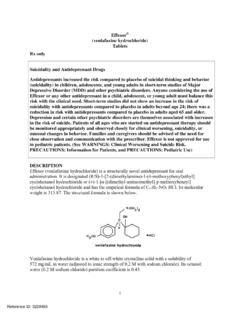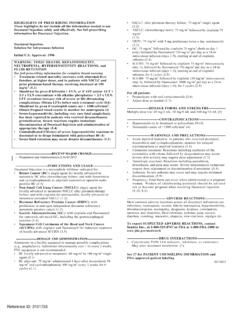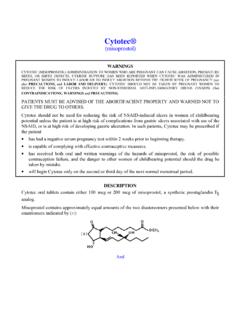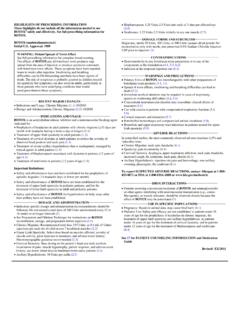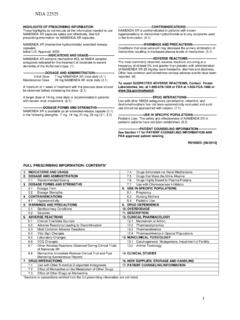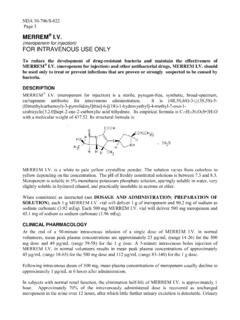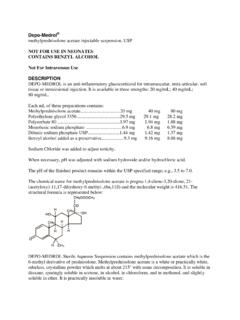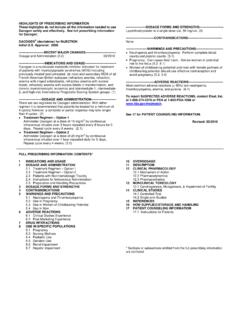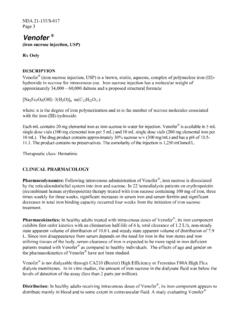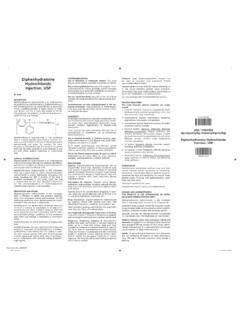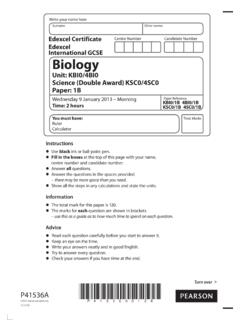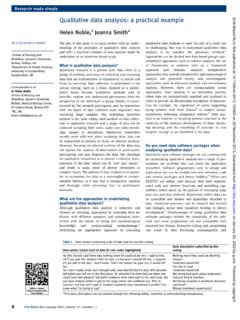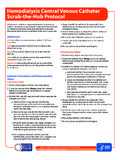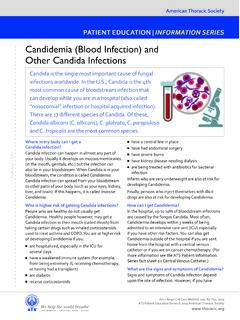Transcription of Reference ID: 3324257 - Food and Drug Administration
1 Page 1 HIGHLIGHTS OF PRESCRIBING INFORMATION These highlights do not include all the information needed to use XGEVA safely and effectively. See full prescribing information for XGEVA. Xgeva (denosumab) injection, for subcutaneous use Initial Approval: 2010 ------------------------------RECENT MAJOR CHANGES------------------------ Indications and Usage ( ) 06/ 2013 Dosage and Administration ( ) 06/ 2013 Warnings and Precautions ( ) 02/ 2013 Warnings and Precautions ( ) 09/2012 Warnings and Precautions ( ) 06/ 2013 --------------------------- INDICATIONS AND USAGE---------------------------- Xgeva is a RANK ligand (RANKL) inhibitor indicated for: Prevention of skeletal-related events in patients with bone metastases from solid tumors ( ) Treatment of adults and skeletally mature adolescents with giant cell tumor of bone that is unresectable or where surgical resection is likely to result in severe morbidity ( , ) Limitation of use.
2 Xgeva is not indicated for the prevention of skeletal-related events in patients with multiple myeloma -----------------------DOSAGE AND Administration ----------------------- Bone Metastasis from Solid Tumors: Administer 120 mg every 4 weeks as a subcutaneous injection in the upper arm, upper thigh, or abdomen ( ) Giant Cell Tumor of Bone: Administer 120 mg every 4 weeks with additional 120 mg doses on Days 8 and 15 of the first month of therapy. Administer subcutaneously in the upper arm, upper thigh, or abdomen ( ) Administer calcium and vitamin D as necessary to treat or prevent hypocalcemia ( ) ----------------------DOSAGE FORMS AND STRENGTHS--------------------- 120 mL (70 mg/mL) single-use vial (3) --------------------------CONTRAINDICATI ONS---------------------------------- None -------------------------WARNINGS AND PRECAUTIONS---------------------- Hypocalcemia: Xgeva can cause severe symptomatic hypocalcemia, and fatal cases have been reported.
3 Correct hypocalcemia prior to initiating Xgeva. Monitor calcium levels and adequately supplement all patients with calcium and vitamin D ( ) Osteonecrosis of the jaw can occur in patients receiving Xgeva. Perform an oral examination prior to starting Xgeva. Monitor for symptoms. Avoid invasive dental procedures during treatment with Xgeva ( ) Embryo-Fetal Toxicity: Can cause fetal harm. Advise females of reproductive potential of potential risk to the fetus and to use highly effective contraception ( , , ) --------------------------------ADVERSE REACTIONS----------------------------- Bone Metastasis from Solid Tumors: Most common adverse reactions (per-patient incidence greater than or equal to 25%) were fatigue/asthenia, hypophosphatemia, and nausea ( ) Giant Cell Tumor of Bone: Most common adverse reactions (per-patient incidence greater than or equal to 10%) were arthralgia, headache, nausea, back pain, fatigue, and pain in extremity ( ) To report SUSPECTED ADVERSE REACTIONS, contact Amgen Inc.
4 At 1-800-77-AMGEN (1-800-772-6436) or FDA at 1-800-FDA-1088 or -------------------------USE IN SPECIFIC POPULATIONS---------------------- Nursing mothers: Discontinue drug or nursing taking into consideration importance of drug to mother ( ) Pediatric patients: Recommended only for treatment of skeletally mature adolescents with giant cell tumor of bone ( ) Renal impairment: Patients with creatinine clearance less than 30 mL/min or receiving dialysis are at risk for hypocalcemia. Adequately supplement with calcium and vitamin D ( ) See 17 for PATIENT COUNSELING INFORMATION. Revised: 06/ 2013 FULL PRESCRIBING INFORMATION: CONTENTS* 1 INDICATIONS AND USAGE Bone Metastasis from Solid Tumors Giant Cell Tumor of Bone 2 DOSAGE AND Administration Recommended Dosage Preparation and Administration 3 DOSAGE FORMS AND STRENGTHS 4 CONTRAINDICATIONS 5 WARNINGS AND PRECAUTIONS Hypocalcemia Osteonecrosis of the Jaw (ONJ)
5 Embryo-Fetal Toxicity 6 ADVERSE REACTIONS Clinical Trials Experience Postmarketing Experience Immunogenicity 7 drug INTERACTIONS 8 USE IN SPECIFIC POPULATIONS Pregnancy Nursing Mothers Pediatric Use Geriatric Use Renal Impairment Females and Males of Reproductive Potential 10 OVERDOSAGE 11 DESCRIPTION 12 CLINICAL PHARMACOLOGY Mechanism of Action Pharmacodynamics Pharmacokinetics 13 NONCLINICAL TOXICOLOGY Carcinogenesis, Mutagenesis, Impairment of Fertility Animal Toxicology and/or Pharmacology 14 CLINICAL TRIALS Bone Metastasis from Solid Tumors Giant Cell Tumor of Bone 16 HOW SUPPLIED/STORAGE AND HANDLING 17 PATIENT COUNSELING INFORMATION * Sections or subsections omitted from the full prescribing information are not listed.
6 Reference ID: 3324257 Page 2 FULL PRESCRIBING INFORMATION 1 INDICATIONS AND USAGE Bone Metastasis from Solid Tumors Xgeva is indicated for the prevention of skeletal-related events in patients with bone metastases from solid tumors. Limitation of Use: Xgeva is not indicated for the prevention of skeletal-related events in patients with multiple myeloma [see Clinical Trials ( )]. Giant Cell Tumor of Bone Xgeva is indicated for the treatment of adults and skeletally mature adolescents with giant cell tumor of bone that is unresectable or where surgical resection is likely to result in severe morbidity. 2 DOSAGE AND Administration Recommended Dosage Bone Metastasis from Solid Tumors The recommended dose of Xgeva is 120 mg administered as a subcutaneous injection every 4 weeks in the upper arm, upper thigh, or abdomen.
7 Administer calcium and vitamin D as necessary to treat or prevent hypocalcemia [see Warnings and Precautions ( )]. Giant Cell Tumor of Bone The recommended dose of Xgeva is 120 mg administered every 4 weeks with additional 120 mg doses on Days 8 and 15 of the first month of therapy. Administer subcutaneously in the upper arm, upper thigh, or abdomen. Administer calcium and vitamin D as necessary to treat or prevent hypocalcemia [see Warnings and Precautions ( )]. Preparation and Administration Visually inspect Xgeva for particulate matter and discoloration prior to Administration . Xgeva is a clear, colorless to pale yellow solution that may contain trace amounts of translucent to white proteinaceous particles. Do not use if the solution is discolored or cloudy or if the solution contains many particles or foreign particulate matter. Prior to Administration , Xgeva may be removed from the refrigerator and brought to room temperature (up to 25 C/77 F) by standing in the original container.
8 This generally takes 15 to 30 minutes. Do not warm Xgeva in any other way [see How Supplied/Storage and Handling (16)]. Use a 27-gauge needle to withdraw and inject the entire contents of the vial. Do not re-enter the vial. Discard vial after single-use or entry. Reference ID: 3324257 Page 3 3 DOSAGE FORMS AND STRENGTHS 120 mL (70 mg/mL) single-use vial. 4 CONTRAINDICATIONS None. 5 WARNINGS AND PRECAUTIONS Hypocalcemia Xgeva can cause severe symptomatic hypocalcemia, and fatal cases have been reported. Correct pre-existing hypocalcemia prior to Xgeva treatment. Monitor calcium levels and administer calcium, magnesium, and vitamin D as necessary. Monitor levels more frequently when Xgeva is administered with other drugs that can also lower calcium levels. Advise patients to contact a healthcare professional for symptoms of hypocalcemia [see Adverse Reactions ( , ) and Patient Counseling Information (17)].
9 Based on clinical trials using a lower dose of denosumab, patients with a creatinine clearance less than 30 mL/min or receiving dialysis are at greater risk of severe hypocalcemia compared to patients with normal renal function. In a trial of 55 patients, without cancer and with varying degrees of renal impairment, who received a single dose of 60 mg denosumab, 8 of 17 patients with a creatinine clearance less than 30 mL/min or receiving dialysis experienced corrected serum calcium levels less than mg/dL as compared to 0 of 12 patients with normal renal function. The risk of hypocalcemia at the recommended dosing schedule of 120 mg every 4 weeks has not been evaluated in patients with a creatinine clearance less than 30 mL/min or receiving dialysis . Osteonecrosis of the Jaw (ONJ) Osteonecrosis of the jaw (ONJ) can occur in patients receiving Xgeva, manifesting as jaw pain, osteomyelitis, osteitis, bone erosion, tooth or periodontal infection, toothache, gingival ulceration, or gingival erosion.
10 Persistent pain or slow healing of the mouth or jaw after dental surgery may also be manifestations of ONJ. In clinical trials in patients with osseous metastasis, of patients receiving Xgeva developed ONJ after a median exposure of 13 doses; of these patients, 79% had a history of tooth extraction, poor oral hygiene, or use of a dental appliance [see Adverse Reactions ( )]. In a clinical trial conducted in patients with prostate cancer at high risk for osseous metastasis, a condition for which denosumab is not approved, of patients developed ONJ after a median exposure of 20 doses. Perform an oral examination and appropriate preventive dentistry prior to the initiation of Xgeva and periodically during Xgeva therapy. Advise patients regarding oral hygiene practices. Avoid invasive dental procedures during treatment with Xgeva. Patients who are suspected of having or who develop ONJ while on Xgeva should receive care by a dentist or an oral surgeon.
